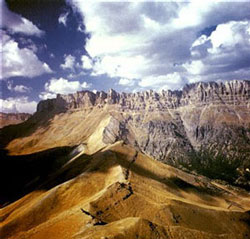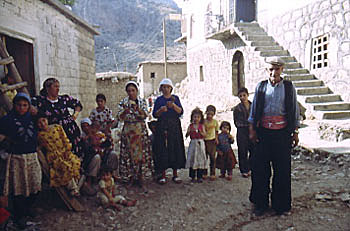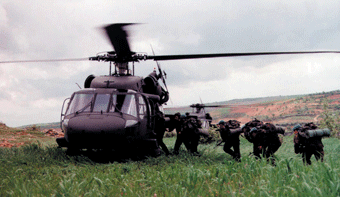|
Modern Times
 View on Mount Judi from Shirnak
Only after the Second World War did the Hasnaye come into contact with the modern world outside their village more regularly. Even now anecdotes connected with these first experiences survive in Mechelen. In the mid-fifties a lorry loaded with goods passed twice a day on the newly constructed gravel road between Cizre and the Iraqi border. The first villager of Hassana who saw this vehicle came running back home and explained to the others that he had seen a man, maybe a Messenger of the Almighty, moving along in the belly of a roaring monster. The villagers thought that a sunstroke had made him go mad. A similar reaction occurred when from the 1960s onwards the first military jets from NATO bases at Diyarbakir or Incirlik (close to Adana) left their trails of white smoke in the sky above Hassana. The Hasnaye crossed themselves whenever they watched these ‘heavenly snakes of God’ crawling out of the blue, high above their heads.
Until 1981, when the World Council of Churches in Europe provided financial aid for the construction of a reliable water supply system, the villagers got their drinking-water from an open well in Upper Hassana, which was fed by melting water from Judi. On hot summer evenings the villagers went to sleep on the flat roofs of their houses and only the flickering light spots from oil lamps twinkled through the darkness. Around 1985 electric power was brought to the village, to meet the needs of the Turkish soldiers who by then were occupying new army barracks on the outskirts of Hassana.
Weaving House
 Hassana - village corner in better times (Horst Oberkampf)
The raw material came from the hair of Kashmir goats, which the Hasnaye bought from Kurdish goatherds. It was washed and the shells of walnuts were used for its natural colouring in various tones of brown. The women of Hassana spun the wool into fine threads; they made their distaffs move while standing on the roof terraces and exterior stone stairs of the houses, or even while sitting on the lower branches of trees. It was a social activity, there was always time for laughter and gossip. The woollen threads were strengthened by putting them in a mixture of cold water and the juice of a root called shivalta; then they were stretched along the edges of the flat roofs and prepared for weaving.
Weaving was a man’s job in Hassana. A lot of houses had a workshop, where men were at work on their small looms. One piece of shella-cloth was about 30 cm wide. Bundles of two of such strips were wound around a metal slat, boiled in hot water and finally pressed for one night in a hollowed-out tree-trunk. The finished textile was a fine piece of shella-cloth with a silky glaze and horizontal creases (1).
Many weavers in Hassana were also tailors. The typical shella-costume for men consisted of three parts: a pair of trousers (shella), a waistcoat without buttons (sapikka) and a jacket with broad sleeves (heleke). Melkan’s father, Ishak, traded in this clothing and he knows the differences in quality quite well. A weaver in Hassana could finish the one-coloured shella-cloth for the simplest costume in one week. At a striped and decorated costume in three tints the tailor worked at least twice as long and for the most expensive one in five colours – the pench mekuk or five shuttles – he needed about a month. The latter one was made on special demand and it was very expensive according to local standards: in 1990 a five stars shella-costume could cost up to 200 US dollars.
One might expect that these traditional weaving techniques would have got completely lost after the eviction of Hassana, but surprisingly enough, they survived in the Diaspora. Just a few years ago an Assyrian workshop started its activities in the centre of Antwerp. It is basically a project for the integration of refugees and it is now trying to become self-supporting. In this Betet Skara or Weaving House the last weavers of Hassana are producing the traditional cloth on small looms, which they themselves assembled. Antwerp fashion designers are interested in this kind of weaving and its recent products have already been shown on the exclusive Paris catwalks. In Betet Skara however Egyptian cotton instead of the original angora wool is used for weaving the traditional cloth and the weavers of Hassana have to accept strict labour conditions. No more time to talk to the customer, Assyrian or Kurd, who once came to order his shella-costume. It is perhaps the ultimate irony of fate that the most tangible cultural pattern of Hassana will only survive in the Diaspora if its last producers are prepared to sell their free Assyrian soul and adapt their old craftsmanship to the capricious taste of the European market (2).
Priests and Healers
Being a weavers’ village, Hassana collected the various threads of Mesopotamian Christianity, as well as age-old relics of superstition. There was never a real doctor in the village, so that the Hasnaye had to rely on faith healers. The last famous of these, quite well remembered by Melkan in his early childhood, was the blind Shamasha (deacon) Kello, who was born in Hassana and died in Bespin. He could sing all the sacred Syriac hymns and it was a common tale in the village that he knew the whole Bible by heart. Even Muslims feared and respected him, and each year again he was given a present by the Kurdish agha. Shamasha Kello would also perform the secret ritual of ktuta, i.e. ‘what is written’. He put a magic charm in a piece of cloth, which was stitched up and given to the person who had revealed his wish to the shamasha. It was strictly forbidden to speak about it or to open the mysterious talisman. Villagers suffering from mental illness wore such amulets or ktiwyateh on their body and could be healed in this way (3).
Up to the 1960s the Protestant house of prayer was the only remaining church in Hassana; Reverend Mattai, grandson of the murdered Qasha Mattai, preached there for the whole community. Then Qasha Toma came to the fore. As a boy he had been a shepherd and later on he was sent to the Syrian-Orthodox Christians of Tur Abdin for his theological education. He was ordained priest and when he returned to Hassana, he rebuilt the old Nestorian Mart Shmuni church in Upper Hassana and started celebrating there. Some villagers felt offended by the way he introduced unfamiliar Syrian-Orthodox practices in his liturgy and they complained to the Chaldean metropolitan at Mardin. So, in the early eighties another priest, Qasha Sliwa, began to spread the Chaldean creed in the village. This Sliwa built his own house of prayer, the New Church as the Hasnaye called it, in the centre of the village. He gained ample recognition, since he was a worthy son of the famous blind healer Shamasha Kello (4).Yet it must be admitted that only Qasha Toma persevered till the end: he took care of his steadily shrinking community until the last Hasnaye, including himself, were forced to leave the village.
Walking in Fear The exodus from Hassana went on for three decades before it reached its fatal climax in 1993. It all started in the early seventies when the first Hasnaye followed the trail of the economic migrants, the Turkish guest workers Europe had asked for. The names of these pioneers are still well-known in Mechelen: Benjamin Dinler and Hanno Dulger, who ended up in Sweden. Benjamin was the first to visit his native village again in 1979. He went around and told his stories. In Europe Christians were free, he said, but everything was very expensive, it was raining most of the time and there was no sun. Towards the end of the seventies at least one member from each family clan had left the village and was living abroad: in Sweden, Germany, France, Holland and Belgium.
 Anti-PKK Operation SE Turkey
In the early eighties the Turkish army constructed new barracks at the entrance of Hassana. In this karakol up to 40 soldiers lived permanently and guarded the village. Later on the army installed a military camp on a hill to the south of Hassnana. From there they used helicopters against the hiding-places of the PKK on Mount Judi.
The last years in Hassana we always walked in fear - this is still a popular saying among the Hasnaye in Mechelen. Besim, a son of Reverend Mattai, was born in Hassana in 1969 and he lived there for twenty years. He remembers a hot summer day when he was working with his friends in the hayfields outside the village. At nightfall they took a swim in a pond nearby, but Turkish soldiers on patrol chased them out of the water and Besim got kicked with the butt of a rifle. The next day he went to the army camp to see the officer in command and tell him that he was beaten up. Surprisingly enough the commandant received him in quite a friendly manner, but then he closed the tent, he took a club and gave him a terrible flogging. Besim was kicked out of the camp and they even threatened to shoot him if he dared to raise his voice ever again. Besim has never forgotten about the incident: “Whenever I think back to it, I feel the headache and if I had had a rifle that day, I would have gone to Judi to join the PKK. These guys didn’t have to recruit new fighters in the villages; the army did it instead of them.” (5)
From 1986 onwards the military authorities appointed village guards all over SE Turkey. Also in Hassana these vigilantes had to go on patrol at night and report about PKK-activities. The Kurdish guerrilla fighters retaliated: one summer evening of 1989 they launched an attack with grenades and machine guns against the Turkish karakol in Hassana. One soldier was killed and several others got seriously injured. After this assault half the population of Hassana fled from the village. During the first Gulf War against Saddam’s Iraq in 1991 another part of the Hasnaye left and never returned.
Chaos and terror reigned in the semi-deserted village; one muhtar after the other ran away for fear of reprisals from the army or from the PKK. In the end only 30 families, 200 persons in total, stayed behind, mainly because they were too poor to emigrate. Mid- November 1993 the Turkish commandant announced that they had one week to evacuate Hassana. The remaining villagers sold their last possessions and already during the general evacuation neighbouring Kurds showed up to take away what was left. Qasha Toma led his small flock to Tur Abdin, where the refugees got shelter at first in the few still inhabited Christian villages of that area. Qasha Toma stayed in Tur Abdin. In the Mor Gabriel monastery (6) a list was composed with the names of the refugees. Later on, in Brussels, Melkan used that list quite frequently: it served to support the requests for asylum of the last Hasnaye who had come to Belgium and wanted to join the Assyrian community in Mechelen.
The Turkish Republic never offered the Christian refugees any form of compensation. Even the Kurdish aghas, who during the massacres of 1915 finally allowed the Christians of Hassana to survive, this time turned against the Hasnaye. A brief report, published on January 31, 1994 by the US Department of State (7) summarizes it all as follows:
'Turkish security forces have been charged with driving 200 Syriac Christians from the village of Hassana (…) in November 1993. According to reports from villagers, the order came to evacuate the village because of a statement by a local tribal leader that it was an Armenian village, and Turkish officials often accuse Armenians of supporting the PKK.'
NOTES
1. See also Hans Hollerweger, Tur Abdin: Living Cultural Heritage (Linz, Freunde des Tur Abdin, 1999), 279-284, with splendid illustrations of the whole process. Also very interesting: Rüdiger Benninghaus, Production, Usage and Diffusion of the sal u sapik Men’s Costume in Turkish Kurdistan (Rüdiger Benninghaus-website).
2. Unfortunately the project could not survive in Antwerp. Betet Skara went bankrupt in 2006.
3. G P Badger, o.c., 238: ‘Thus they [the Nestorians of Hakkari] have charms against the evil eye, the poison of reptiles and plants (…) the tyranny of rulers and the designs of wicked men, most of which adverse influences are believed to be destroyed by certain passages of Holy Writ which are profanely used to this end.’ See also Erica Hunter, Amulets and the Assyrians of Kurdistan, JAAS Vol IX No 2 (November 1995).
4. Qasha Sliwa emigrated to Marseille (France), where he continued his work as a priest for the Assyrian families in that town. In 2006 he came to Mechelen and since then he has been living again among the Hasnaye, just like in Hassana, as their own qasha.
5. Hasnaye in Mechelen keep silent about their unintended part in the conflict. In Hassana they had no real choice, but it is obvious that there was bad and worse: they wouldn’t have taken the side of the Turkish army, which acted as an occupying force.
6. The seat of the Syrian-Orthodox Metropolitan, Archbishop Timotheos Samuel Aktas.
7. Part of the broader survey Turkey Human Rights Practices 1993.
|

 Mechelen on Tigris
Mechelen on Tigris  The Long Exodus
The Long Exodus

 Mechelen on Tigris
Mechelen on Tigris  The Long Exodus
The Long Exodus